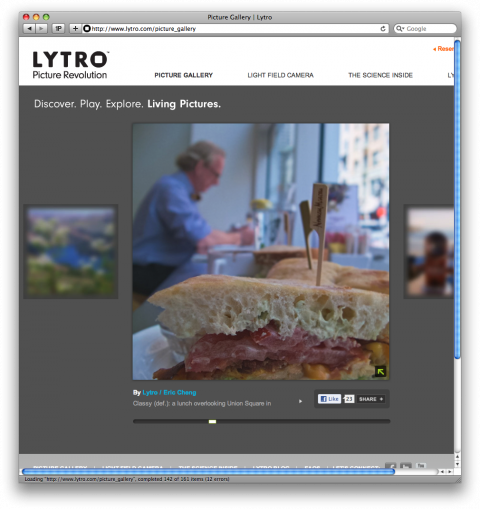Lytro is a camera that lets you focus on shooting and not worry about focusing. You can do that later. It sounds too good to be true, if you ask me, but seriously fascinating. Try it on their site by clicking anywhere in the sample photos to focus on that element of the picture. I can not wait to see this in action.
(Thanks Rusty)

Not to be the grammar police, but this is your second post in as many weeks that uses “let’s” instead of the correct “lets.” I overlooked last week’s “let’s” as a fluke, but now I’m sad. I expect higher quality proofing from Swissmiss!
Jun 22nd, 2011 / 5:37 pm
It’s *currently* too good to be true, but it’s not as bad as you’d think. It’s pretty amazing technology. Here’s the thesis [PDF] behind it. http://www.lytro.com/renng-thesis.pdf
The current prototype only allows for about a 2MP resolution. This is because a microlens is placed on top of the conventional sensor to capture the light field, so you’d need a more sensitive sensor to collect more data – it will need to utilize more powerful sensors to get some of the quality we’re used to on higher-end DSLRs.
Give it a few years to mature and this stuff is going to turn the world of photography on its head.
Jun 22nd, 2011 / 5:48 pm
Ordy, sorry you are disappointed. Maybe I should just switch my blog to german, that’s my first language.
Jun 22nd, 2011 / 6:07 pm
[I think what Ordy meant to say, Tina, is that he’s become so accustomed to the impeccable quality of your blog, he’s caught off-guard by the occasional slip-up]
This is awesome technology, and completely feasible! (Albeit costly for the near future.) There have been demos of similar systems (e.g., by Adobe) for quite a while, but this seems more elegant (and more advanced) than the typical “plenoptic lens” approach. Thanks for posting – I’m excited about this! (Though I can’t grasp how significantly this would alter the photography world.)
Jun 22nd, 2011 / 7:22 pm
Awesomerobot, that thesis is very fascinating. I can totally see how this will be rattling the photography world. Good on them for coming out with it. I hope they have a good patent. It will make them very rich.
Jun 22nd, 2011 / 8:48 pm
mmm… sandwich…aarrrghhh
Jun 23rd, 2011 / 7:18 am
Is there a picture of the Lytro camera prototype? I didn’t find one on the Lytro web site.
Jun 23rd, 2011 / 10:28 am
This is absolutely phenomenal… It is yet another way to separate the requirement for technical skills to use a camera. I like that fact that there’s no shutter lag due to the fact that there’s no focusing.
But it will certainly allow for very interesting creative expression and probably s’more time spent post-processing though…
Amazing, amazing stuff…
Jun 23rd, 2011 / 11:07 am
This is going to be an amazing technology I’m sure law enforcement/security/etc. would appreciate using.
It kinda reminds me of the Foveon X3 chip that Sigma uses for their digital cameras…
–S
Jun 23rd, 2011 / 11:13 am
Craziness!
Jun 23rd, 2011 / 3:24 pm
not to be the bad guy here, but there’s a few issues with this technology:
-lenses (especially working with slr’s and in motion pictures) have a characteristic bokeh or defocused area, with a blur that is part of the lens’ character. this here emulates it by adding digital blur into the image. of course for quick snapshot pics that might work, but, like hipstamatic, it’s more of a toy/fancy effect than anything else. or a different way of taking pictures altogether.
but, not a replacement for actual focus stuff…
i guess that’s what i wanted to say.
Jun 23rd, 2011 / 3:53 pm
@Elias, this technology doesn’t add a digital blur – for all intents and purposes it’s *actual blur* – the software simply selects the correct light from the recorded information; nothing that wasn’t there to begin with gets added. No emulation is happening here, the camera takes a photo and captures (just about) every available light possibility.
Jun 24th, 2011 / 1:35 pm
Hey, T – Do you know if Mailchimp is planning to create a more mobile-friendly email template? I was trying to figure out how I missed this and realized it’s prolly because I was looking at your daily email update on my phone. In some cases embedded stuff doesn’t display or when it does, it’s not optimized (size-wise) for mobile. (At which point I tell myself that I’ll check it out on my desktop when I’m back on my computer, then I’m distracted by something shiny or get hungry and wander off…) Anyway, not a criticism – I’m just curious if our chimpy pals are planning to change this at some point?
Your friend,
bb
Jun 24th, 2011 / 5:04 pm
@awesomerobot,
what i meant to say (i believe) is that the characteristics of the lens you use gets lost. and that is – at least for me – a loss in quality, depending on the glass used.
but possible that my mind is not able to process that whole technique, i simply can’t believe that choosing focus past the lens is creating the same (not similar looking) image. i just can’t get around that.
but thanks for that insight, maybe some more?
or does this simply mean that the image size is about a terabite per pic, cause it photographs all possible focus points? and how does it do that within a 1/100 of a second (or 1/1000)?
Jun 24th, 2011 / 5:55 pm
This is just crazy….! I am going to wait and see how this revolutionizes the photography!
Jun 26th, 2011 / 10:58 pm